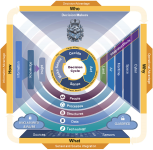
cimsec.org
This article references explicitly the needs of Maritime Strike given the preponderance of Over-The-Horizon / Beyond-Visual-Range munitions on the developing battlespace. I included it under artillery and the multi-domain discussion because it seems to me to apply equally to the terrestrial and aerial domains.
The article discusses the following munitions:
MST - Maritime Strike Tomahawk (1000 nm @ 450 knots) - Time to target 2 hours 13 minutes
LRASM - Long Range Anti-Ship Missile (200 nm @ 450 knots) - Time to target 27 minutes
NSM - Naval Strike Missile (115 nm @ 450 knots) - Time to target 15 minutes
PrSM - Precision Strike Missile (350 nm @ 3334 knots) - Time to target 6 minutes
SM-6 - Standard Missile 6 (130 nm @ 2334 knots) - Time to target 3 minutes
The argument is the need for better long range targeting info and the requirement to get Space Force data integrated into the kill loops in a timely manner.
I think the PrSM and SM-6 information could be revised a bit.
Starting with the PrSM. This can be launched from the MFOM pods on vehicles like the M270, HIMARS, AML (CAML-M) and Chunmoo
Increment 1 is in service with the Australians since July 2025 - The "Treaty" Range is 500 km which is a bit less than the 350 nm cited above (648 km) - it is designed fo use against static surface targets
Increment 2 is the Land Based Anti-Ship Missile that is in development - the current range is the same as increment 1 but is projected to increase to at least 1000 km, or twice the nominal range of increment 1 and it is expected to be faster - the seeker will engage moving targets.
Increment 3 will add new warheads to the basic missile - anti-structure unitary warheads and smart sub-munitions (drones)
Increment 4 aims to increase the range beyond 1000 km
Increment 5 aims to incorporate the PrSM missiles on to the AML (Autonomous Multi-Domain Launcher) / CAML-M (Common Autonomous Multi-Domain Launcher - Medium) - a 6x6 truck similar to the HIMARS.
The PrSM presents some interesting challenges for the RRCA/RCN/RCAF. The same weapon system (the HIMARS truck) will be able to launch against tactical targets at 15 km range and strategic targets at ranges approaching 1500 km. That puts them in competition with the Tomahawk systems.
....
SM-6 aka Standard Missile 6 aka RIM-174 Standard Extended Range Active Missile (ERAM). Recently joined by the AIM-174B - same missile but with the booster removed for launch by F-18s.
The SM-6, currently in widespread service is to joint the Tomahawk in the Typhon Mk70 PDS as a stable mate. That would mean that the SM-6 and the Tomahawk can be launched from aircraft, trucks and other terrestrial platforms, ships and submarines. The Tomahawk will give the system a range of 1500 km.
The SM-6 range cited of 130 nm (240 km) is the published Surface to Air range. When employed in the Surface to Surface role then the range is believed to be in excess of 500 km, possibly considerably so. The Air to Surface (Ground) range, launched from an F18 at altitude and lofted, is unpublished to suspected of being multiple hundreds of nautical miles.
....
The NSM/JSM is launchable from the same platforms as the SM-6 and Tomahawk.
....
The LRASM is validated for the B1 Lancer and the F15E Strike Eagle.
It is being integrated or considered for the F15EX, F/A18E-F, F35, P8, Mk41VLS/Mk70PDS, and HIMARS/AML.
....
All of this suggests to me that the technology is avaialable to overcome the geography of Canada. A relatively small number of missiles, centrally located at 2 or 3 bases (1 to 5 possibly) could supply the government a timely response against a variety of possible but unlikely targets. The issue would be how quickly could they respond for a request for support from a lightly armed observer.







